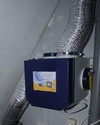Every recent house (build from the late 1980’s and up) has one installed: a forced air ventilation unit. Isolation is important, but what most people forget: good ventilation is also a must. Ventilation and isolation go hand in hand… In my house a system was also installed, with as a beating heart the JE StorkAir CMFe ventilation unit. The noise it emitted was disturbing (for me), and after a calculation I was amazed. This thing wastes lots of energy, and emits noise also…. Therefore I compared it to another ventilation unit (the Itho EcoFan 2) and… immediate upgraded this system for a brand-new Itho unit.
This report has been originally posted on Februari 1st, 2008 on my own Dutch website
As a bonus was included in my salary, I opted for durable investment. For some time I own a house, and due to (Dutch) regulations a forced air ventialtion unit is installed, combined with some special type windows.
Nothing wrong with it, but… it COULD be better. Because I’ve found out most of the company only calculate the easiest way to deliver an item for the lowest price, without regarding energy-efficiency etc. So it is quite easy to understand the ventilation unit is one of the type “It does it’s job, but don’t mind the bill” 😉
I started to compare the current unit with the Itho CVE Eco-Fan 2 unit. Luckily all ventilation-connections are standardized for easy replacement. Only thing you have to pay attention to is the wiring inside the PERILEX connecter, and verify if all 3 settings (low, medium, high) will work after installation.

The old JE StorkAir CMFe unit
In this enclosed Excel sheet, on which I used the same calculations for the ITHO unit you can see the differences. Be aware, I couldn’t trace the correct taxes, deductions and energy-prices. WIth my own ventilation-plan, I could calculate the immediate impact.
The Specification phase
With both brochures and Excel on the laptop some remarkable points were noted:
The StorkAir uses between 7 en 73 Watt, the ITHO between 3,2 and 28 Watt. See the first improvement? 😉
Het noise both units emit to the area. The Storkair produces between 35 en 67 db(A), the ITHO between 30,2 en 56,4 db(A). So you can imagine how silently the Itho will do it’s job. A reduction of 3dB(A) is experienced for a human like turning the volume halfway down! Please note: the medium-setting for the Itho can not be determined easily, as it is determined by setting 1 (low ventilation) and setting 3 (maximum ventilation).
Ventilation capacity for the ITHO is maxed out at/around 325 m3 per uur, and defaulted from factory on 225 m3 per hour. The StorkAir is between 100 (minimal) en 350 m3 (maximum ventilation) per hour.
Sadly for me, it wasn’t possible to verify the power-consumption, because of the PERILEX connector. Therefore verification with real-life situations can not be done…
The savings
The savings depend on your own (personal) ventilation-behaviour. Personally I am often away, and return in the evening at home. My estimated ventilation-scheme were fed into the excel-sheet.
With setting of 0 hour setting 0 (minimal ventilation), 23 hour setting 1 (medium ventilation), and 1 hour setting 3 (hig/maximum ventilation) my savings are:
- 230 kWh electricity saved (73 kwh for the ITHO versus 303 kWh for Storkair);
- financially 40 EUR per year saved (due to the more efficient Itho unit);
- CO2 emissions reduced with 75% (113kg for StorkAir against 27 kg for ITHO);
Ofcourse these figures are derived from calculations. I wish I could verify these in real-life situations. But it will be verified by the utility company when I (again) used less and less electricity… 😀
Investment on the ITHO Eco-Fan 2 for me at that very moment (Februari 2008) was 190 EURO.
Installation took me about half an hour, most of the time was taken by the re-wiring of the Perilex connector and some testing of the 3 settings. The ITHO Eco-Fan 2 unit is installed “as-is” without changing defaulted settings.





